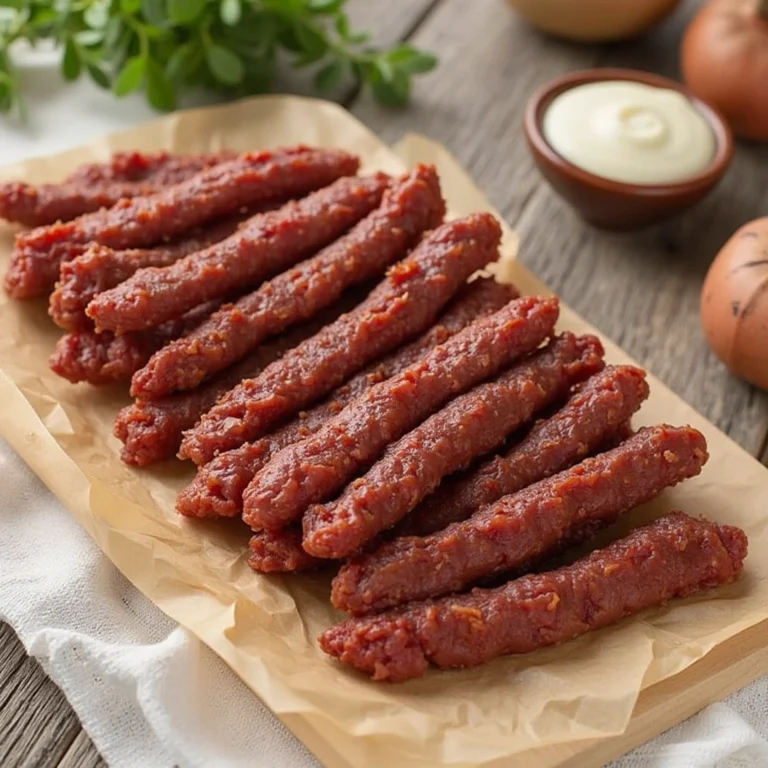Meat sticks might just be the ultimate snack. I realized this on a road trip through the Rockies—tired, hungry, and too far from the next diner. I pulled a pack of smoky beef sticks from my bag, took one bite, and instantly felt revived. It wasn’t just the rich, savory flavor or the protein punch—it was the comfort of something familiar, portable, and incredibly satisfying.
Over time, that quick fix became a pantry staple. Whether I’m hiking, hustling between meetings, or just craving something hearty without the fuss, meat sticks always hit the spot. They’re more than just a snack—they’re fuel, flavor, and tradition all rolled into one.
In this guide, we’ll take a flavorful journey through the world of meat sticks—exploring different types (beef, turkey, venison, and beyond), their nutritional perks, how they’re made, and why they’ve stood the test of time. We’ll also dive into how to enjoy them creatively and even share step-by-step instructions for making your own homemade batch. If you’ve ever reached for a meat stick and wondered what makes it so satisfying, you’re about to find out.
Table of Contents
Table of Contents
What Are Meat Sticks?
Meat sticks are seasoned, dried, and often smoked meat snacks that are typically made from beef, turkey, pork, or exotic meats like venison, elk, or bison. They are a staple in high-protein diets and have gained popularity among those following keto, paleo, and low-carb lifestyles. Unlike potted meat, which is spreadable and often used for sandwiches, meat sticks are firm, chewy, and designed for easy snacking.
Compared to potted meat, which is spreadable and often used for sandwiches, meat sticks are firm and chewy, making them a perfect on-the-go snack.
Why Are Meat Sticks So Popular?
Meat sticks have surged in popularity for several reasons:
- High in Protein:
Meat sticks are an excellent source of protein, making them ideal for muscle recovery after workouts or as a filling snack to keep hunger at bay. Most meat sticks contain 6–12 grams of protein per serving. - Shelf-Stable:
Thanks to their curing and drying process, meat sticks can last for months without refrigeration. This makes them perfect for outdoor activities like hiking, camping, or traveling. - Keto & Low-Carb Friendly:
Many meat sticks are free from added sugars and carbs, aligning with keto, paleo, and low-carb diets. They’re also gluten-free, making them suitable for those with dietary restrictions. - Variety of Flavors:
From classic smoky beef to spicy jalapeño or sweet teriyaki, there’s a flavor for every palate. Exotic options like venison or bison cater to adventurous eaters. - Portability:
Their compact, durable form makes them easy to carry in a gym bag, backpack, or even a pocket. Unlike other protein snacks like shakes or bars, they don’t require preparation or refrigeration. - Minimal Ingredients:
High-quality meat sticks often contain simple ingredients like meat, salt, spices, and natural preservatives, avoiding artificial additives.
Types of Meat Sticks
Meat sticks come in a variety of types, each offering unique textures and flavors. Here’s a breakdown of the most popular options:
1. Beef Sticks
The most common variety, beef sticks are made from lean beef and are often smoked for extra flavor. Grass-fed beef sticks are a healthier option, as they contain higher levels of omega-3 fatty acids and fewer additives.
2. Turkey Sticks
A leaner alternative to beef, turkey sticks are high in protein but lower in fat. They’re a great option for those looking to reduce their calorie intake without sacrificing flavor.
3. Pork Sticks
Known for their rich, juicy texture, pork sticks often contain natural fats that enhance their flavor. They’re a favorite among those who enjoy a more indulgent snack.
4. Venison and Exotic Meat Sticks
These include options like elk, bison, and even alligator meat sticks. Exotic meat sticks are higher in protein and leaner than beef, making them a great choice for health-conscious snackers.
How Are Meat Sticks Made?
The process of making meat sticks involves several steps:
- Meat Selection:
High-quality cuts of beef, turkey, pork, or exotic meats are chosen. - Grinding & Seasoning:
The meat is ground and mixed with salt, spices, and natural preservatives. - Stuffing:
The seasoned meat is filled into casings, which can be natural or synthetic. - Drying & Smoking:
The sticks are smoked or dehydrated to remove moisture and enhance flavor. This process also helps preserve the meat, making it shelf-stable.
This method is similar to how smoking turkey breast enhances flavor while keeping it juicy and tender.

Are Meat Sticks Healthy?
Yes! Meat sticks can be a healthy and convenient snack when chosen wisely.
Health Benefits of Meat Sticks
✅ High in Protein – Helps build and repair muscles.
✅ Low in Carbs – A perfect keto snack.
✅ Rich in Iron & B Vitamins – Supports energy production.
✅ Convenient – No cooking or prep required.
However, it’s essential to watch for added ingredients like preservatives, excess sodium, and sugars. If you’re looking for healthier meat options, check out veal meat or canned meat as leaner alternatives.
Best Ways to Enjoy Meat Sticks
While meat sticks are delicious on their own, they also work well in a variety of recipes. Here are some creative ways to enjoy them:
1. Meat Stick & Cheese Platter
Pair sliced meat sticks with cheddar, gouda, and crackers for a classic charcuterie board. This works well with bread and cheese combinations for a satisfying snack or appetizer.
2. Meat Stick & Pasta Dishes
Chop meat sticks and add them to pasta sauces for a savory, smoky twist. They pair particularly well with creamy sauces like garlic parmesan chicken pasta.
3. Meat Stick & Egg Scramble
Dice up some meat sticks and mix them into scrambled eggs for an extra protein boost. This is a great way to start your day with a high-protein breakfast.
4. Meat Stick Pizza Topping
Instead of pepperoni, use sliced meat sticks as a tasty topping on your homemade pizza. Their smoky flavor adds a unique twist to this classic dish.
Where to Buy Meat Sticks
You can find meat sticks in:
🏪 Grocery Stores – Walmart, Whole Foods, Trader Joe’s
🛒 Online Retailers – Amazon, Thrive Market, ButcherBox
📦 Subscription Boxes – Monthly snack boxes featuring high-protein options
If you’re looking for other protein-packed meals, check out high-protein lunch ideas.

Homemade Meat Sticks Recipe
Want to make meat sticks at home? Here’s how!
Ingredients:
- 1 lb ground beef, turkey, or venison
- 1 tsp salt
- 1 tsp black pepper
- ½ tsp garlic powder
- ¼ tsp paprika
- 1 tbsp Worcestershire sauce
- Casings (optional)
Instructions:
Store: Keep the meat sticks in an airtight container for up to a month.
Mix the Ingredients: Combine all ingredients in a bowl until well mixed.
Shape into Sticks: Form the mixture into sticks or use a meat gun to fill casings.
Dehydrate: Place the sticks on a dehydrator tray and dehydrate at 160°F for 4–6 hours.
For more homemade recipes, check out potted meat recipes!
Key Takeaways:
- Meat sticks are high in protein and low in carbs, making them ideal for keto, paleo, and low-carb diets.
- They are shelf-stable and portable, perfect for on-the-go snacking.
- You can enjoy them on their own or incorporate them into recipes for added flavor and protein.
- Making your own meat sticks at home allows you to control the ingredients and create healthier alternatives.
Frequently Asked Questions (FAQs) About Meat Sticks
1. What are meat sticks?
Meat sticks are seasoned, dried, and often smoked meat snacks made from beef, turkey, pork, or exotic meats like venison or bison. They are firm, chewy, and portable, making them a popular high-protein snack for on-the-go consumption.
2. Are meat sticks healthy?
Yes, meat sticks can be a healthy snack when chosen wisely. They are high in protein, low in carbs, and rich in iron and B vitamins. However, some brands may contain high sodium levels or artificial additives, so it’s important to read labels and opt for minimally processed options.
3. Are meat sticks keto-friendly?
Most meat sticks are keto-friendly because they are low in carbs and high in protein. However, always check the label for added sugars or fillers that might not align with a strict keto diet.
4. How long do meat sticks last?
Meat sticks are shelf-stable and can last for months without refrigeration, thanks to their curing and drying process. Once opened, it’s best to consume them within a few days or store them in the refrigerator to maintain freshness.
5. What’s the difference between meat sticks and jerky?
While both are dried meat snacks, jerky is typically sliced thin and can be tougher, whereas meat sticks are ground, seasoned, and formed into a cylindrical shape. Meat sticks often have a softer, chewier texture compared to jerky.
6. Can I make meat sticks at home?
Yes, you can make meat sticks at home using ground meat, spices, and a dehydrator or smoker. Homemade meat sticks allow you to control the ingredients and create healthier, customized versions.
7. What types of meat are used in meat sticks?
Meat sticks are commonly made from beef, turkey, pork, or exotic meats like venison, elk, or bison. Each type offers a unique flavor and texture, catering to different preferences.
8. Are meat sticks gluten-free?
Most meat sticks are gluten-free, but it’s always a good idea to check the label for any gluten-containing ingredients or cross-contamination warnings, especially if you have celiac disease or gluten sensitivity.
9. Can I eat meat sticks on a paleo diet?
Yes, meat sticks are a great snack for the paleo diet, as they are made from whole, unprocessed meats and contain no grains or artificial additives. Look for brands that use natural ingredients and avoid added sugars.
10. Are meat sticks high in sodium?
Some meat sticks can be high in sodium due to the curing process. If you’re watching your sodium intake, look for low-sodium options or make your own at home to control the salt content.
Final Thoughts: Are Meat Sticks Worth It?
If you’re looking for a high-protein, convenient, and tasty snack, meat sticks are an excellent choice. They’re perfect for travel, work, or gym snacks, and their variety of flavors ensures there’s something for everyone. By choosing high-quality options or making your own at home, you can enjoy this delicious snack while staying true to your dietary goals.
Looking for more meat-based ideas? Explore beef slow cooker recipes for delicious meal prep ideas!

